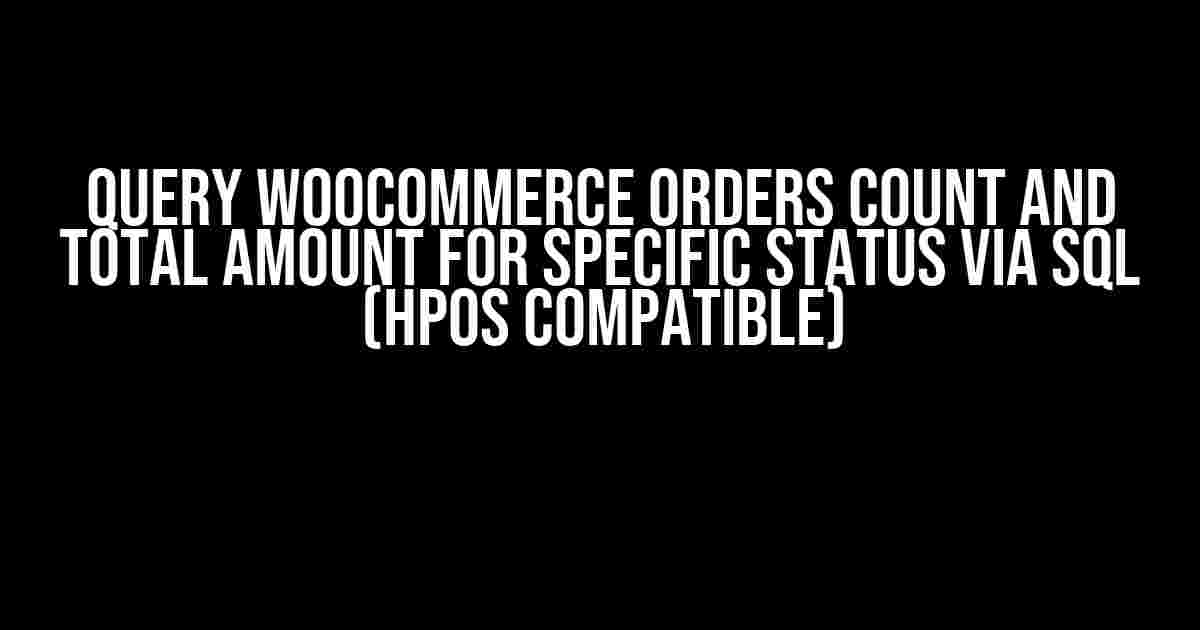Are you tired of digging through WooCommerce’s cumbersome order management system to get a glimpse of your store’s performance? Do you want to know the exact number of orders and total amount for a specific status, such as “processing” or “completed”? Look no further! In this article, we’ll show you how to query WooCommerce orders count and total amount for specific status via SQL, making it compatible with High-Performance Order Storage (HPOS).
Why Use SQL?
WooCommerce provides an overwhelming amount of data, making it challenging to extract the information you need. That’s where SQL comes in – a powerful language that allows you to query and manipulate data in your database. By using SQL, you can bypass WooCommerce’s GUI and get the exact data you need, quickly and efficiently.
Prerequisites
Before we dive into the SQL queries, make sure you have the following:
- A WooCommerce store with High-Performance Order Storage (HPOS) enabled
- Access to your WordPress database using phpMyAdmin or a similar tool
Querying WooCommerce Orders Count and Total Amount
Let’s get started with the SQL queries. We’ll cover two scenarios: getting the count of orders for a specific status and getting the total amount for a specific status.
Counting Orders for a Specific Status
Use the following SQL query to get the count of orders for a specific status:
SELECT COUNT(*) AS order_count
FROM wp_wc_orders
WHERE status = 'status_name';
Replace `status_name` with the desired status, such as “processing”, “completed”, or “cancelled”. For example:
SELECT COUNT(*) AS order_count
FROM wp_wc_orders
WHERE status = 'processing';
This query will return the count of orders with the “processing” status.
Total Amount for a Specific Status
Use the following SQL query to get the total amount for a specific status:
SELECT SUM(total) AS total_amount
FROM wp_wc_orders
WHERE status = 'status_name';
Replace `status_name` with the desired status, such as “processing”, “completed”, or “cancelled”. For example:
SELECT SUM(total) AS total_amount
FROM wp_wc_orders
WHERE status = 'completed';
This query will return the total amount of orders with the “completed” status.
HPOS Compatibility
If you’re using High-Performance Order Storage (HPOS), you’ll need to modify the queries to accommodate the new table structure. HPOS introduces a separate table for order items, `wp_wc_order_items`, which we’ll need to join with `wp_wc_orders` to get the desired data.
Counting Orders for a Specific Status (HPOS)
Use the following SQL query to get the count of orders for a specific status in HPOS:
SELECT COUNT(DISTINCT wo.id) AS order_count
FROM wp_wc_orders wo
JOIN wp_wc_order_items woi ON wo.id = woi.order_id
WHERE wo.status = 'status_name';
Replace `status_name` with the desired status, such as “processing”, “completed”, or “cancelled”. For example:
SELECT COUNT(DISTINCT wo.id) AS order_count
FROM wp_wc_orders wo
JOIN wp_wc_order_items woi ON wo.id = woi.order_id
WHERE wo.status = 'processing';
This query will return the count of orders with the “processing” status in HPOS.
Total Amount for a Specific Status (HPOS)
Use the following SQL query to get the total amount for a specific status in HPOS:
SELECT SUM(wo.total) AS total_amount
FROM wp_wc_orders wo
JOIN wp_wc_order_items woi ON wo.id = woi.order_id
WHERE wo.status = 'status_name';
Replace `status_name` with the desired status, such as “processing”, “completed”, or “cancelled”. For example:
SELECT SUM(wo.total) AS total_amount
FROM wp_wc_orders wo
JOIN wp_wc_order_items woi ON wo.id = woi.order_id
WHERE wo.status = 'completed';
This query will return the total amount of orders with the “completed” status in HPOS.
Putting it All Together
Now that we have the individual queries, let’s combine them to get a comprehensive view of your WooCommerce orders.
Orders Count and Total Amount for Specific Statuses
Use the following SQL query to get the count and total amount for multiple statuses:
SELECT
status,
COUNT(*) AS order_count,
SUM(total) AS total_amount
FROM
wp_wc_orders
WHERE
status IN ('status1', 'status2', 'status3')
GROUP BY
status;
Replace `status1`, `status2`, and `status3` with the desired statuses, such as “processing”, “completed”, and “cancelled”. This query will return a result set with the count and total amount for each specified status.
Conclusion
Querying WooCommerce orders count and total amount for specific status via SQL is a powerful way to get the insights you need to optimize your store’s performance. By using the queries provided in this article, you can bypass WooCommerce’s GUI and get the exact data you need, quickly and efficiently. Remember to adjust the queries according to your HPOS setup and experiment with different statuses to get a comprehensive view of your store’s performance.
Additional Resources
If you’re new to SQL or need further assistance, here are some additional resources to help you get started:
Frequently Asked Questions
If you have any questions or need further clarification, please don’t hesitate to ask:
| Question | Answer |
|---|---|
| What is High-Performance Order Storage (HPOS)? | HPOS is a WooCommerce feature that improves order management performance by storing order data in a separate table. |
| Can I use these queries with other eCommerce plugins? | No, these queries are specifically designed for WooCommerce. If you’re using a different eCommerce plugin, you’ll need to adapt the queries to match the plugin’s database structure. |
| How do I modify these queries to suit my specific needs? | You can modify the queries by adjusting the WHERE and GROUP BY clauses, as well as adding or removing columns from the SELECT statement. Experiment with different variations to get the desired output. |
We hope this article has provided you with the knowledge and tools to query WooCommerce orders count and total amount for specific status via SQL. Happy querying!
Here are 5 FAQs about “Query WooCommerce orders count and total amount for specific status via SQL (HPOS compatible)”:
Frequently Asked Questions
Get answers to your most pressing questions about querying WooCommerce orders count and total amount for specific status via SQL, compatible with HPOS.
What is the purpose of querying WooCommerce orders count and total amount for specific status via SQL?
Querying WooCommerce orders count and total amount for specific status via SQL allows you to retrieve a detailed report of your store’s performance, helping you make informed business decisions and optimize your sales strategy.
How do I query WooCommerce orders count and total amount for specific status via SQL?
You can use the following SQL query: SELECT COUNT(*) as total_orders, SUM( postmeta.meta_value ) as total_amount FROM wp_posts AS posts LEFT JOIN wp_postmeta AS postmeta ON posts.ID = postmeta.post_id WHERE posts.post_type = 'shop_order' AND posts.post_status = 'your_status_here' AND postmeta.meta_key = '_order_total';, replacing ‘your_status_here’ with the desired order status.
What is HPOS compatibility, and why is it important?
HPOS (Hierarchical Product Order System) is a feature in WooCommerce that allows for efficient management of complex product orders. Ensuring that your SQL query is HPOS compatible means that it can handle orders with variations and hierarchical structures, providing an accurate count and total amount for specific order status.
Can I modify the SQL query to filter orders by date range?
Yes, you can modify the SQL query to filter orders by date range by adding a `WHERE` clause with a date range condition, for example: WHERE posts.post_date >= '2022-01-01' AND posts.post_date <= '2022-01-31', adjusting the dates according to your needs.
What are some common use cases for querying WooCommerce orders count and total amount for specific status via SQL?
Some common use cases include tracking order fulfillment rates, monitoring sales performance, identifying trends in customer behavior, and generating reports for business intelligence and analytics.



